Jeff and Debbie's
1999 Nahanni Canoe Trip
Back to menu
Aug.17: Yellowknife to Fort Simpson to Rabbitkettle Lake
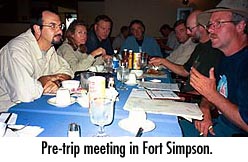 We woke relatively early and took what was going to be our last "civilized" hot shower
for two weeks. I was interested to see odd-looking characters beneath the English on
the shampoo bottle, and found out later that the language was Inuktitut. After a
leisurely breakfast in the hotel restaurant, Jeff and I visited a small shop on the main
floor where I bought a Yellowknife t-shirt. We took the shuttle back to the
airport where several sandhill cranes wheeled in the sky high above us as we
waited for our flight.
We caught a First Air flight to Fort Simpson, which is located on an island
in the Mackenzie River and has a population of about 1200.
We woke relatively early and took what was going to be our last "civilized" hot shower
for two weeks. I was interested to see odd-looking characters beneath the English on
the shampoo bottle, and found out later that the language was Inuktitut. After a
leisurely breakfast in the hotel restaurant, Jeff and I visited a small shop on the main
floor where I bought a Yellowknife t-shirt. We took the shuttle back to the
airport where several sandhill cranes wheeled in the sky high above us as we
waited for our flight.
We caught a First Air flight to Fort Simpson, which is located on an island
in the Mackenzie River and has a population of about 1200.
MAP: Here's a
map showing flight routes
(courtesy Nahanni River Adventures site).
Our route: Edmonton -> Yellowknife -> Fort Simpson -> Rabbitkettle.
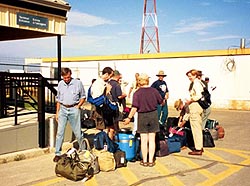
After being greeted by Nahanni
Wilderness Adventures guide Dave Hibbard, and Canoe North guides Al Pace and Lin Ward, we
loaded our gear into vans and drove to the Nahanni Inn for some lunch. Karen Bergman-Illnik, another
guide, joined us. Over lunch, we all introduced ourselves and gave some background on why
we were here as well as what we were hoping to get out of the trip. After a brief discussion
of the upcoming itinerary, we set off in the vans for the guides' compound. The compound consisted mainly of a number of trailers belonging to various outfitting companies, and we used this location
to transfer our gear and supplies to drybags and barrels. Our city clothes and luggage would
be kept here until we returned from the river.
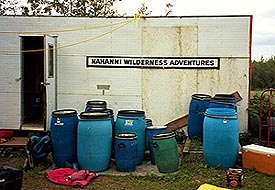 I should say something about drybags and barrels here, since they became an integral part
of our life for the next ten days. Our personal gear was stuffed into large, yellow bags
made of a heavy plastic. After filling the bags, you rolled down the tops and fastened
them with clips. Closed correctly, these drybags were essentially waterproof, protecting your
gear from the rain and canoe dumps. Each bag came with a harness so that you could carry
the bag on your bag, knapsack-style. The barrels are exactly what you'd expect...big
plastic barrels with screw-on or snap-on lids. These tended to contain foodstuffs; they were more
bearproof than the drybags, but also more of a pain to carry unless you had a really good
harness. Jeff and I took a barrel on our last canoe trip, and I had a red bruise mark on
my lower back for days.
I should say something about drybags and barrels here, since they became an integral part
of our life for the next ten days. Our personal gear was stuffed into large, yellow bags
made of a heavy plastic. After filling the bags, you rolled down the tops and fastened
them with clips. Closed correctly, these drybags were essentially waterproof, protecting your
gear from the rain and canoe dumps. Each bag came with a harness so that you could carry
the bag on your bag, knapsack-style. The barrels are exactly what you'd expect...big
plastic barrels with screw-on or snap-on lids. These tended to contain foodstuffs; they were more
bearproof than the drybags, but also more of a pain to carry unless you had a really good
harness. Jeff and I took a barrel on our last canoe trip, and I had a red bruise mark on
my lower back for days.
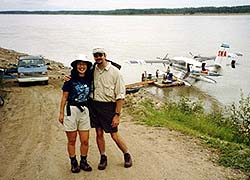
After transferring our gear to drybags and barrels, we halved the group for travelling to
Rabbitkettle since the Twin Otter float plane would only carry six people plus the pilot,
gear, and several canoes. The first group to go over consisted of me, Jeff R., Frebis, Duane, Karen, and
Al. After dropping us off, the plane would return for the second group four hours later. I was amazed at how much equipment and supplies we managed to fit into the plane! The
passenger seats were along one side; we had to awkwardly clamber over
canoes and other gear to reach them. As we took off from the water, we pressed our faces to the glass and waved frantically to the rest of the group waiting on the dock. The flight was about an hour and a half, and we took turns sitting in the co-pilot's chair in the cockpit. When it was my turn, Jacques (the pilot) motioned for me to put on the headset so we could talk to each other. At first I was impressed just with the view of the cloud formations all around us, but then the plane broke through the clouds and I was greeted by a spectacular view of the sunlit Mackenzie Mountains ahead.
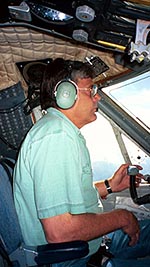
Although I tend to be prone to motion sickness, I was fine on the flight. I did take half a Gravol just in case, but had no problem; neither did anyone else. Jeff pulled out his topographic maps and we'd compare them to the landscape features passing by below. Karen pointed out some of the major features that she recognized from previous trips.
It was difficult to hold any conversation over the roar of the engines. From time to time we would yell comments to each other, but spent most of our time watching the rugged landscape unfold below. I could sense all of us pressing closer to the
glass when the Nahanni River finally appeared, twisting through the valley. The Nahanni is unusual in that the mountains rose around it 200 million years ago, rather than the river cutting through an already-existing range. Rivers of this type are called antecedent rivers, and tend to meander in a winding fashion through canyons rather than straight and deep.

At one point, someone called out excitedly and pointed out a single red canoe on the water far below. Jacques brought the plane lower, and soon we were circling our destination: Rabbitkettle Lake (legend has it that the lake waters used to be hot enough to cook a rabbit in, hence the name). A few minutes later we were splashing through the water, and the plane pulled up to the dock just outside of the wardens' cabin. Jacques took off as soon as we had all our gear and canoes unloaded...he did a half-circle after taking off; we cheered and waved as he soared directly over our heads in an impressively steep climb into the sky.
While waiting for the others to arrive, we set up camp. Karen started a fire and heated up a big pot of Hungarian goulash she had prepared earlier.
For appetizers,
she filled a pot with nachos, poured salsa and grated cheddar cheese on top, and then heated up the pot over the fire, letting the cheddar melt over the nachos. We waited until the others arrived before starting dinner. Great goulash, and then a freshly-baked gingerbread-apple cake concoction called "Bears Lost In The Apple Orchard" for dessert.
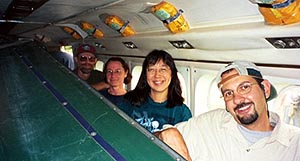
Jeff, Al and I portaged some gear over to the Nahanni River side of the campground...my first glimpse of the river! Faster-moving than I expected; I could feel my mouth dry up and stomach tighten, just looking at it. I had utterly no whitewater experience and very little experience on moving water...what on earth was I doing here?
Jeff hauled the gear we had brought over up a ladder to store on the food cache. The cache was basically a small, trangular platform mounted on sturdy poles, high above the reach (hopefully) of bears and other animals. I couldn't help but notice the long scratches on the poles, some reaching far higher than the tallest of our group. Yikes.

Bears were a major topic throughout our trip since we were in bear country. Al talked to us about bears on the first day of our trip as did Carl Lafferty, the Rabbitkettle Park Warden. No food or fragranced material in our tents (even toothpaste was frowned upon). Avoid straying away from the campsite by yourself. Always make noise when travelling through the bush to avoid surprising a bear. And never, ever run. We saw several black bears during the trip, but always from the river, never around the campsite...though we did see black bear and grizzly tracks quite frequently. The guides always carried pepper sprays, but we had been warned that these sprays didn't always work...each bear was different.
Later in the evening, I published the first issue of Nahanni News (I had prepared some paper before the trip) and encouraged everyone to add to it during the trip.
Tomorrow...our first night on the Nahanni!
Back |
Next
 We woke relatively early and took what was going to be our last "civilized" hot shower
for two weeks. I was interested to see odd-looking characters beneath the English on
the shampoo bottle, and found out later that the language was Inuktitut. After a
leisurely breakfast in the hotel restaurant, Jeff and I visited a small shop on the main
floor where I bought a Yellowknife t-shirt. We took the shuttle back to the
airport where several sandhill cranes wheeled in the sky high above us as we
waited for our flight.
We caught a First Air flight to Fort Simpson, which is located on an island
in the Mackenzie River and has a population of about 1200.
We woke relatively early and took what was going to be our last "civilized" hot shower
for two weeks. I was interested to see odd-looking characters beneath the English on
the shampoo bottle, and found out later that the language was Inuktitut. After a
leisurely breakfast in the hotel restaurant, Jeff and I visited a small shop on the main
floor where I bought a Yellowknife t-shirt. We took the shuttle back to the
airport where several sandhill cranes wheeled in the sky high above us as we
waited for our flight.
We caught a First Air flight to Fort Simpson, which is located on an island
in the Mackenzie River and has a population of about 1200.

 I should say something about drybags and barrels here, since they became an integral part
of our life for the next ten days. Our personal gear was stuffed into large, yellow bags
made of a heavy plastic. After filling the bags, you rolled down the tops and fastened
them with clips. Closed correctly, these
I should say something about drybags and barrels here, since they became an integral part
of our life for the next ten days. Our personal gear was stuffed into large, yellow bags
made of a heavy plastic. After filling the bags, you rolled down the tops and fastened
them with clips. Closed correctly, these 



